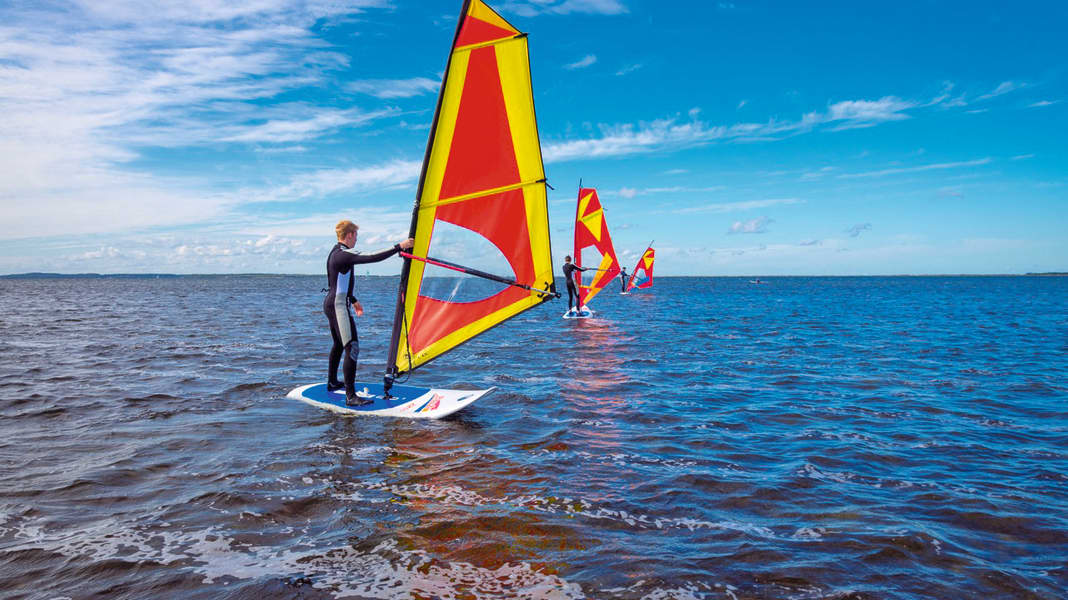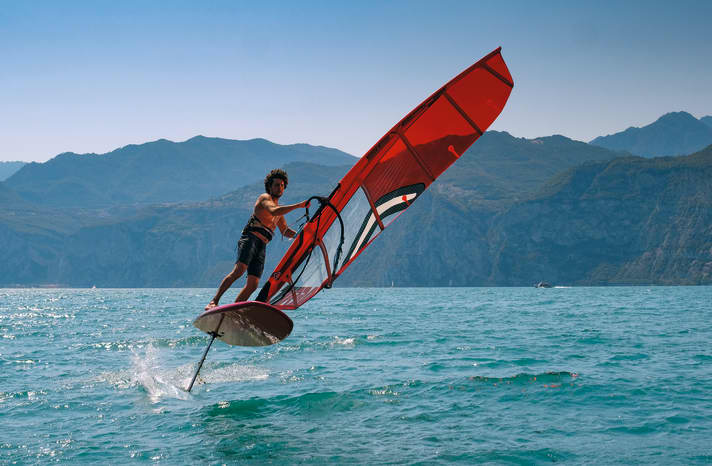
Where can I learn to windsurf?
The first port of call for windsurfing beginners should always be a surf school. It doesn't matter whether you choose a small surf school at the quarry pond around the corner or a large centre at your holiday destination. The important thing is that the centre has experienced instructors and the right equipment. Even with a short and inexpensive taster course, anyone can stand on a board for the first time and get a feel for the sail.
The instructors at the surf school provide the right guidance to avoid typical beginner mistakes. This leads to quick learning success and increases motivation to keep going! At the end of the course, you often receive your windsurfing licence, which allows you to hire equipment at many stations and is required to surf on some waters.
The VDWS (Association of German Windsurfing Schools) will help you find the right surf school! There are also schools at numerous spots abroad. Another option are Windsurfing camps Here you can learn intensively in a group, practise freely and also have lots of fun out of the water!
Is windsurfing difficult?
Yes and no. During the first few attempts, it can seem complicated to keep your balance and align the sail correctly. Gusty winds or choppy water can also cause beginners to despair at times. But with the right equipment and good instructors, these hurdles are quickly forgotten and there are plenty of successes to be had. From the first longer ride straight ahead, the first successful tack or jibe, the first time you feel the sensation of gliding, to the first jumps or more challenging manoeuvres, there are always new milestones and motivational boosters to achieve. Windsurfing never gets boring!
How dangerous is windsurfing?
Windsurfing is a natural sport and the power of nature should never be underestimated. But if you follow a few simple rules, windsurfing is a very safe sport. If you fall off the board, you usually just get wet, nothing more.
The first safety question should be asked on land: Are the spot and the conditions suitable for my ability? Beginners should make sure that there is ideally a large area where they can still stand. This saves an energy-sapping swim and allows you to simply walk back to the beach if in doubt. The wind should not be too strong at the beginning and should blow onshore so that you don't drift off. Offshore winds are much more dangerous, as they naturally push the surfer away from the shore, possibly even out to sea. In addition, offshore winds are usually noticeably gustier and more unpredictable due to buildings or trees close to the shore.
The biggest danger for beginners is getting the rig on their head when falling. This can be prevented with a simple trick: If you feel yourself falling into the water, hold the boom with at least one hand and stretch your arms. This ensures that the mast or boom does not come off.
It also makes sense to wear the right protective equipment: a long wetsuit not only protects you from the cold, but also prevents abrasions. A Impact protection or buoyancy waistcoat provides safety and protects the body, a surf helmet protects the head.
What do I need for windsurfing?
Windsurfing equipment consists of a board with a fin at the rear end, which is responsible for directional stability. Beginner boards usually have a folding centreboard in the middle, which provides additional stability. Advanced boards have foot straps that ensure a firm grip on the board.
The rig, consisting of sail, mast and boom, is connected to the board via a movable rubber joint (mast foot). Sails for beginners usually have around three to five square metres, the boards 160 to 220 litres in volume. Ideal for the first steps can also be a WindSUP, i.e. a SUP with the option of windsurfing.
If you go to a surf school, you don't have to worry about finding the right equipment, as the ideal equipment is perfectly set up there. We strongly advise against buying supposedly cheap boards and sails that have been sitting in a garage for years and are now being offered by ignorant people. Outdated equipment is not only dangerous, but can also quickly frustrate beginners because it is heavy and unsuitable!
How much does windsurfing cost?
The good news is that although the wind is not always reliable, it is free! If you don't own any windsurfing equipment, you can hire the right equipment from numerous schools and centres. The advantage of this is that intermediates can permanently adapt their equipment and use the optimum sizes as they make rapid progress. Equipment hire usually costs between 20 and 50 euros per day, the longer the hire period, the cheaper it becomes. There are often pool offers where the equipment can be changed at will.
If you want to buy your own equipment, you should budget around 1500 to 2000 euros for a complete set. Used equipment is cheaper, but it may take a little more effort to get all the necessary parts together.
Depending on where you live, there are also travel and transport costs to the spot, as well as any parking fees.
What equipment do I need to learn windsurfing?
Windsurfing equipment consists of a board with a fin, mast foot and possibly a centreboard and foot straps. The rig consists of a sail, a mast, a boom (or boom for short) and a mast extension. There is also a wetsuit and, depending on the temperature and conditions of the spot, neoprene shoes. Advanced windsurfers also use a harness to hold the rig.
Can I teach myself to windsurf?
"Just try it out" can satisfy your initial curiosity, but if you have a little ambition, you should seek professional support. Even though there are numerous online tutorials and textbooks, the easiest and quickest way to learn windsurfing is in a surf school (see above). A few specific tips from the trainer often help you to make rapid progress.
What are the worst beginner mistakes in windsurfing?
The worst mistakes are actually the wrong equipment, an unsuitable spot or conditions that are too demanding. If you avoid these mistakes, you're already doing almost everything right. Mistakes on the water are avoided through good training, and every surf student quickly realises how the equipment reacts.
How much volume do I need for windsurfing?
The rule of thumb is that the volume of the windsurf board for beginners should be about 100 litres more than the body weight in kilograms. Most beginner boards have 160-250 litres and therefore offer sufficient reserves. Ideally, children should start on slightly smaller boards so that they can give steering impulses more easily.
What is the difference between windsurfing and wingsurfing?
Wingsurfing is a relatively new sport in which a kind of wing is used instead of a rig with a fixed mast and boom. This is kept in shape with tightly inflated air tubes, similar to a kite. The wing is held by straps or short poles and is not firmly attached to the board. The board often has a foil, i.e. a wing that lifts it out of the water and significantly reduces drag.
- All information about wingsurfing can be found at wingsurf.world!
Who invented windsurfing?
Windsurfing was invented in 1967 by the American Jim Drake. In the surf interview, his son explains how the idea came about and how the patent dispute with Hoyle Schweitzer later arose >>
How do I start planing while windsurfing?
When the wind, sail and board work well together, a windsurfing board starts planing. This planing is the prerequisite for many advanced manoeuvres and higher speeds. Here we explain the best way to guide >>
When is windsurfing prohibited?
Windsurfing is prohibited if, for example, waters are designated as a nature reserve. Windsurfing is also not permitted on many beaches in order not to endanger swimmers. In most cases, special areas for windsurfing are designated on somewhat secluded sections of the beach. You should always enquire about the local conditions before going out on the water. It is also not permitted to windsurf in the marked shipping lanes.
Why should I windsurf?
Because it's the best sport in the world! :-)
What types of windsurfing are there?
For advanced windsurfers, there are several types of windsurfing available, whereby the route taken usually depends on the area and individual skills and preferences.
Freeride
Relaxed cruising without necessarily wanting to reach the highest top speed or perform special manoeuvres - apart from jibes and turns
Waveriding
The supreme discipline: In mostly challenging conditions with high waves and strong winds, waves are ridden down and jumps are performed
Freestyle
Technically demanding manoeuvres and tricks on flat water.
Slalom/Racing
Races on the water with specialised equipment; a course marked with buoys is used for regattas
Speed
Ride as fast as possible along a set route (usually 500 metres), measured by a radar trap. Professionals in this discipline use extremely specialised equipment and prefer very smooth water
Foiling
Instead of a fin, there is a kind of hydrofoil under the board, which lifts the board and surfer even at low speeds and allows them to virtually fly. Due to the low resistance, higher speeds are possible even with little wind. Foils are used both for racing and freeriding, and freestyle tricks are also possible.


